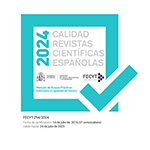En los márgenes del canon y al borde de la sinrazón. Georg Büchner y el mundo al revés de Leonce und Lena
Resumen
La obra de Büchner tuvo que esperar casi un siglo a ser apreciada o siquiera conocida. Aunque actualmente se le incluye dentro de las Historias de la literatura, alemana y universal, como uno de los grandes autores del XIX, no termina de encajar en ninguna de las categorí- as en las que se estudian las distintas épocas y tendencias (como tampoco Kleist, Hölderlin, Jean Paul o Heine) y siempre queda clasificado como "inclasificable". Ya es un autor canó- nico, pero dentro del canon se considera un caso aparte. Por otro lado, también los recursos formales y temáticos que utiliza pueden considerarse marginales en el sentido de "transgresores " o "llevados hasta el último extremo". La comedia Leonce und Lena (1836) es en apariencia su obra más ligera y amable pero, en realidad, revela una forma y un dramatismo tan grotescos, radicales y modernos como el resto.Descargas
Descarga artículo
Licencia
La Revista de Filología Alemana, para fomentar el intercambio global del conocimiento, facilita el acceso sin restricciones a sus contenidos desde el momento de su publicación en la presente edición electrónica, y por eso es una revista de acceso abierto. Los originales publicados en esta revista son propiedad de la Universidad Complutense de Madrid y es obligatorio citar su procedencia en cualquier reproducción total o parcial. Todos los contenidos se distribuyen bajo una licencia de uso y distribución Creative Commons Reconocimiento 4.0 (CC BY 4.0). Esta circunstancia ha de hacerse constar expresamente de esta forma cuando sea necesario. Puede consultar la versión informativa y el texto legal de la licencia.










